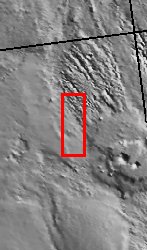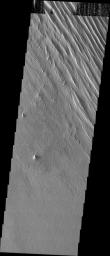
Released July 21, 2004
The atmosphere of Mars is a dynamic system. Water-ice clouds, fog, and hazes can make imaging the surface from space difficult. Dust storms can grow from local disturbances to global sizes, through which imaging is impossible. Seasonal temperature changes are the usual drivers in cloud and dust storm development and growth.
Eons of atmospheric dust storm activity has left its mark on the surface of Mars. Dust carried aloft by the wind has settled out on every available surface; sand dunes have been created and moved by centuries of wind; and the effect of continual sand-blasting has modified many regions of Mars, creating yardangs and other unusual surface forms.
In this image we can clearly see a major change in wind regimes. The classic yardang form occupies the top of the image. These older yardangs were formed by a NW/SE wind regime. The younger, smaller yardangs are forming in the rest of the image from a NE/SW wind. The age relationship is readily visible at the intersection area, where the large yardangs are being cut crosswise into NE/SW aligned forms. The top framelet of this image has vertical black/white lines caused by charge on the camera CCD.
Image information: VIS instrument. Latitude -6.3, Longitude 183.8 East (176.2 West). 19 meter/pixel resolution.
Note: this THEMIS visual image has not been radiometrically nor geometrically calibrated for this preliminary release. An empirical correction has been performed to remove instrumental effects. A linear shift has been applied in the cross-track and down-track direction to approximate spacecraft and planetary motion. Fully calibrated and geometrically projected images will be released through the Planetary Data System in accordance with Project policies at a later time.
NASA's Jet Propulsion Laboratory manages the 2001 Mars Odyssey mission for NASA's Office of Space Science, Washington, D.C. The Thermal Emission Imaging System (THEMIS) was developed by Arizona State University, Tempe, in collaboration with Raytheon Santa Barbara Remote Sensing. The THEMIS investigation is led by Dr. Philip Christensen at Arizona State University. Lockheed Martin Astronautics, Denver, is the prime contractor for the Odyssey project, and developed and built the orbiter. Mission operations are conducted jointly from Lockheed Martin and from JPL, a division of the California Institute of Technology in Pasadena.

 Planetary Data System
Planetary Data System













